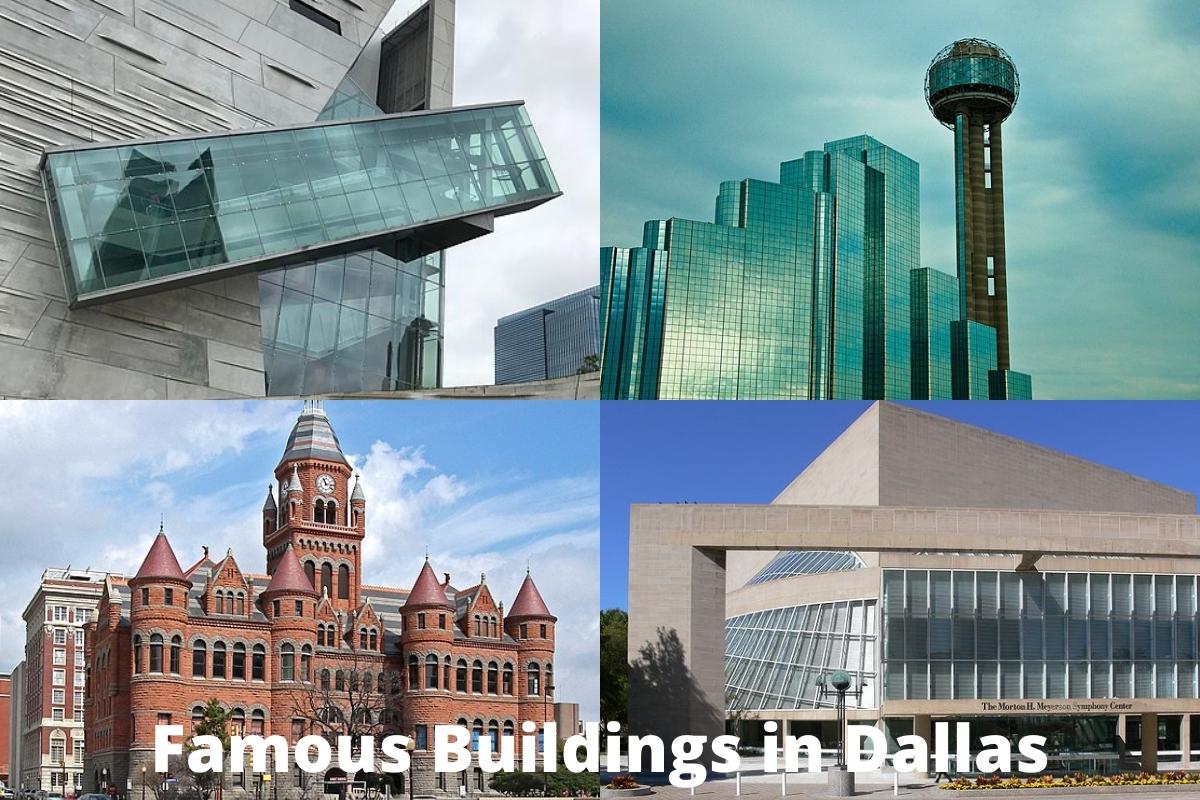From breathtaking museums to courthouses and bank towers, and even villages, the architecture in Dallas, Texas is a sight to behold.
The architecture here ranges from Romanesque to Beaux Arts and postmodernism.
Here is a list of the ten most famous buildings in Dallas that it would be remiss of you not to visit.
Famous Buildings in Dallas
1. Fountain Place
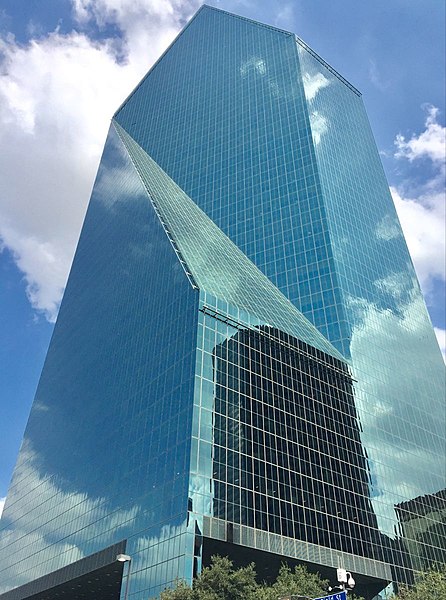
The 58-story glass pyramid that is Fountain Place is an iconic symbol of Dallas.
The tower, which was designed by renowned architects I.M. Pei and Harry Cobb of I.M. Pei Partners is currently undergoing a $70 million interior renovation that will include an original cast glass art installation by artist John Lewis.
Also Read: Famous Landmarks in Texas
Several new eateries you’ll find on the plaza at Fountain Place, which was built by renowned landscape architect Dan Kiley.
It features dancing fountains spanning 1.7 acres, trees, and meeting areas. As of 2019, AMLI at Fountain Place, a glass tower rising 45 stories, has provided hundreds of new apartments to the Arts District’s Fountain Place.
2. Reunion Tower
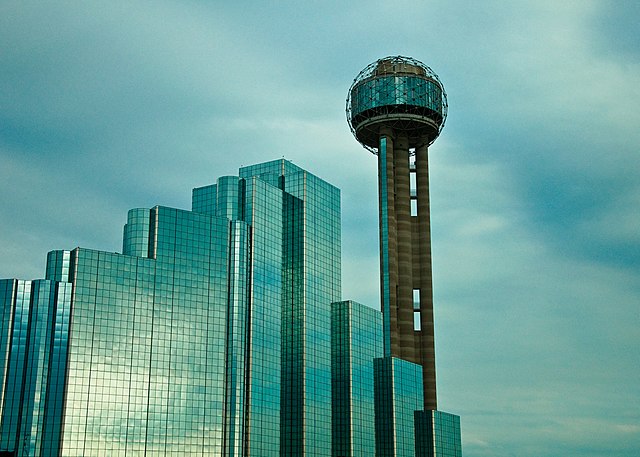
Among the most well-known structures in Dallas, Texas is the 561-foot-tall Reunion Tower. As part of the Hyatt Regency Hotel, you’ll find it at 300 Reunion Boulevard in the Reunion neighborhood of downtown.
The building, developed by Welton Becket & Associates, stood alone until an extension was built to the hotel in 1998.
The tower has four concrete spires that support three levels with circular floor designs. Stairs and mechanical components are located in a central cylindrical shaft.
Elevators are located in three separate rectangular shafts that rise in parallel to the main shaft.
Glass panels line the exterior of each elevator shaft, giving visitors a bird’s-eye view of the city during the 68-second ascent. A geodesic dome made of aluminum struts encloses the building’s upper three stories.
Every night, 259 bespoke LED lamps made by Altman Lighting and Color Kinetics illuminate the building’s globe.
3. Thanks-Giving Square
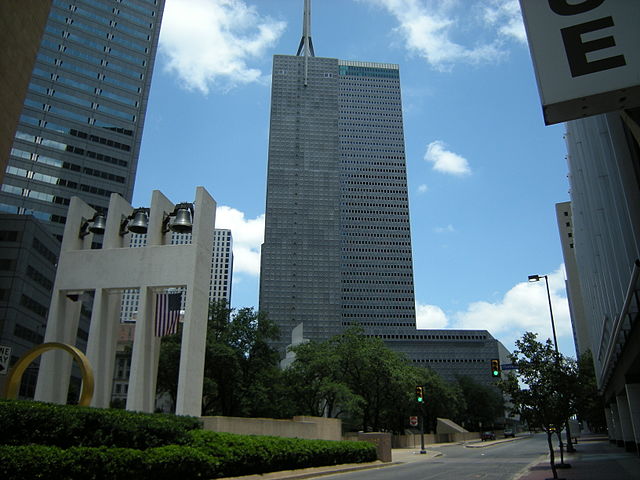
The Thanksgiving Commercial Center neighborhood in downtown Dallas, Texas, United States is centered on Thanks-Giving Square, a private park and public facility.
The Bullington Truck Terminal, a sizable subterranean pedestrian system, and a manicured garden were all added to the complex after it was dedicated in 1976.
This relationship between the public and private sectors was the first of its type in Dallas. Peter Stewart, a Dallas investor and among the founding members of the Thanks-Giving Foundation, conducted an exhaustive international search for an architect and ultimately settled on Philip Johnson.
Thanks-Giving Square was supposed to be the first of five traffic-relieving structures in the heart of Dallas.
One of the main aspects of the plan is the Bullington Truck Terminal, which was built to centralize street-level delivery vehicles after Dallas’ fast expansion in the mid-20th century.
It was anticipated that 350 trucks each day could be taken off the streets above ground if truck traffic was transferred underground. In 1972, as part of the city’s bond program, $6.5 million was issued for the project, and by 1977, construction was complete.
4. Dallas County Courthouse
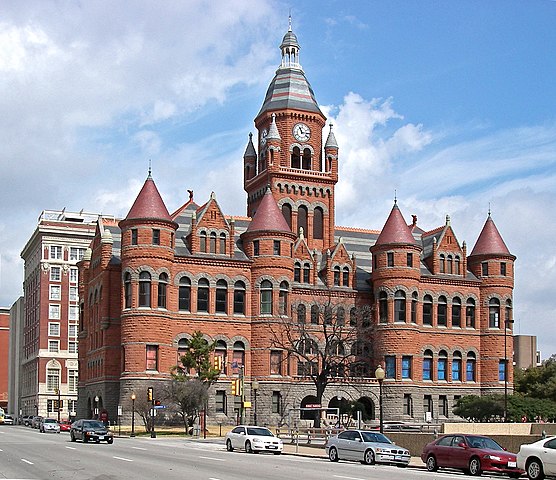
In 1892, the notable Dallas County Courthouse, situated at 100 South Houston Street, was constructed. It comprises rustic marble accents, along with red sandstone, and is a significant example of the city’s administrative architecture.
It was the county courthouse until 2007 when it was converted into the Old Red Museum, a center for regional history.
Orlopp & Kushner’s architect, Max A. Orlopp, Jr. created the building in the Richardsonian Romanesque style. A new courthouse was constructed nearby in 1966 and it eventually superseded the older one.
It was entered on the National Register of Historic Places on December 12, 1976. The structure had renovations between 2005 and 2007.
5. Perot Museum of Nature and Science
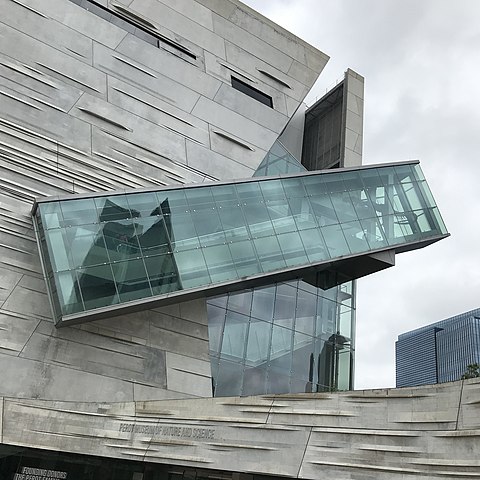
In Dallas, Texas’s Victory Park is where you’ll find the Perot Museum of Nature and Science (abbreviated as the Perot Museum).
Ross and Margot Perot are being honored with the museum bearing their names after it received a $50 million donation from the Perots’ five grown children.
All costs associated with buying the land, designing the exhibits, and building the new structure were covered by the $185 million fundraising goal.
With a total floor area of 180,000 square feet spread across 6 stories, this building is nearly 14 stories tall.
There are eleven permanent exhibit rooms and six instructional labs spread throughout its five publicly accessible floors. The museum’s management is located on the upper floor.
On December 1, 2012, the Victory Park location officially welcomed its first students. On its first day of opening, the museum received about 6,000 guests.
6. Morton H. Meyerson Symphony Center
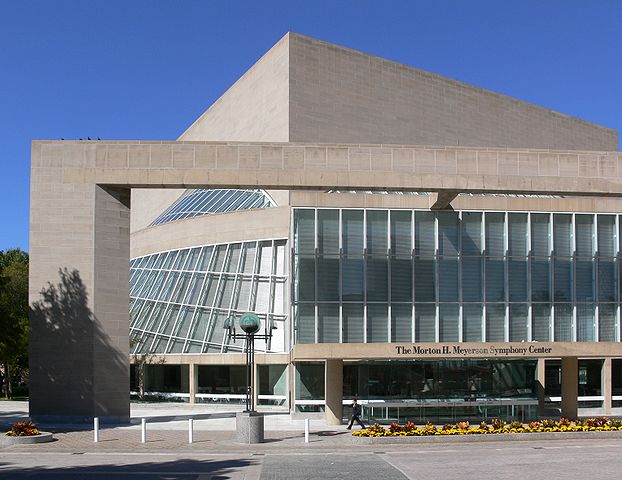
Located in Dallas, Texas’s central Arts District, the Meyerson Symphony Center is a world-class music auditorium.
Also Read: Buildings in Texas
It was developed by acclaimed architect I.M. Pei along with renowned acoustician Russell Johnson and is widely considered to be among the finest concert halls worldwide.
Leslie E. Robertson Associates provided structural engineering services for this September 1989 opening.
Morton Meyerson, a past president of Electronic Data Systems as well as former chairman and chief executive officer of Perot Systems, spearheaded the Dallas Symphony Organisation’s 10-year drive to build the Meyerson Symphony Center, which now serves as the city’s symphony orchestra’s home.
In 1986, at H. Ross Perot’s urging, the new concert hall was given his name in exchange for a naming rights contribution of $10 million. Meyerson Symphony Center is a city-owned venue that is managed by the Dallas Symphony Orchestra.
7. Bank of America Plaza (Dallas)
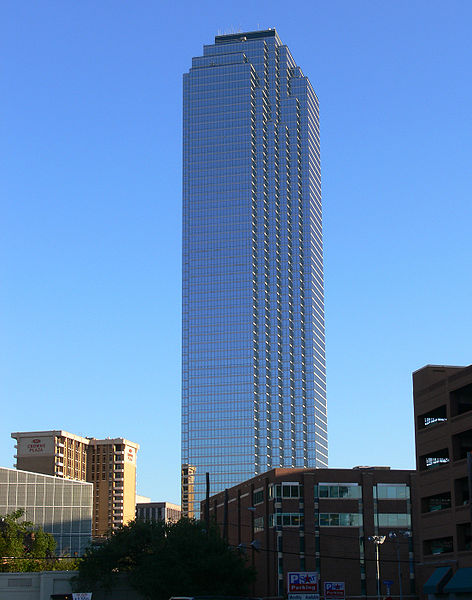
The Main Street District of Dallas, Texas’s downtown is home to Bank of America Plaza, a 72-floor, 921-foot late-modernist skyscraper.
The building ranks as the tallest in the city, the third tallest in the state, and the 40th in America.
There are almost 1,900,000 square feet of office space there. Construction of the building was overseen by Bramalea Limited of Canada, and developed by JPJ Architects.
The initial owner was a partnership between First National Bank of Dallas, Bramalea Limited, and Prudential Insurance. The tower’s construction began in 1983, and it was finished in 1985.
8. Chase Tower (Dallas)
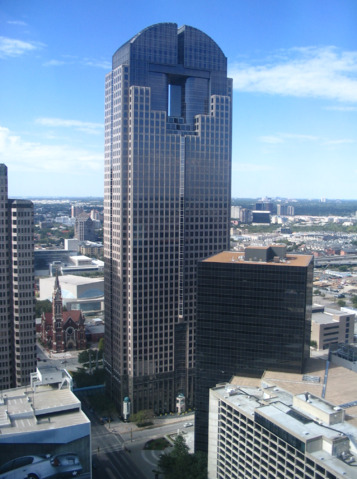
The Chase Tower is a postmodern, 55-story tower at 2200 Ross Avenue in Dallas’s City Center neighborhood.
It has a height of 738 feet. Excluding spires and antennas, it would be the city’s third-tallest skyscraper but is only the fourth-tallest overall. It is the twelfth-tallest structure in the Lone Star State.
The structure was finished in 1987 after being designed by the architectural firm Skidmore, Owings & Merrill. On floors 39 and 40, the Dallas Petroleum Club operates as a social and business club for the building’s tenants.
Also Read: Famous Buildings in New Orleans
Some have dubbed this structure the “Keyhole Building” because of its distinctive design, which features a curved glass roof plus a six-story hole in the tower’s center at the top.
9. Dallas Heritage Village
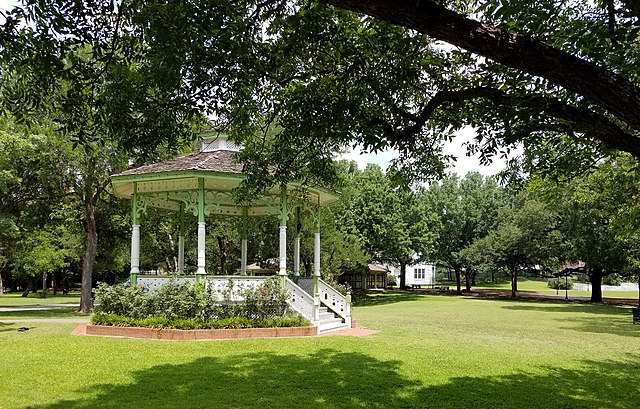
The property on which Old City Park is built has deep historical roots in Dallas. This area was the first city park in Dallas, established in 1876.
To the people of that time, it was known simply as City Park. In the late 19th century, the area around City Park developed into The Cedars, an exclusive community that became home to many prominent figures in the local business and commercial communities.
This was the site of the city’s first zoo, and concerts were held every week in a bandstand quite similar to the one still in use today. A wooden water pipe brought water from Browder Springs, currently flowing underground, to the developing city.
There are greenhouses, a pond, a pump house, a fountain, and a big pavilion depicted on maps from the turn of the century. In the daytime, visitors could stroll through the greenhouses.
The future of City Park appeared bleak after World War II, but a group of women fighting to protect a famous plantation home from demolition saw an opportunity for the park to play an important cultural role in Dallas.
After dismantling Millermore, the rescuing women put the pieces in storage and contacted Park Board’s president, Ray Hubbard.
He consented to their plan to move the house to City Park and rebuild it there as the first of twenty-one structures to form a hamlet.
10. Majestic Theatre, Dallas
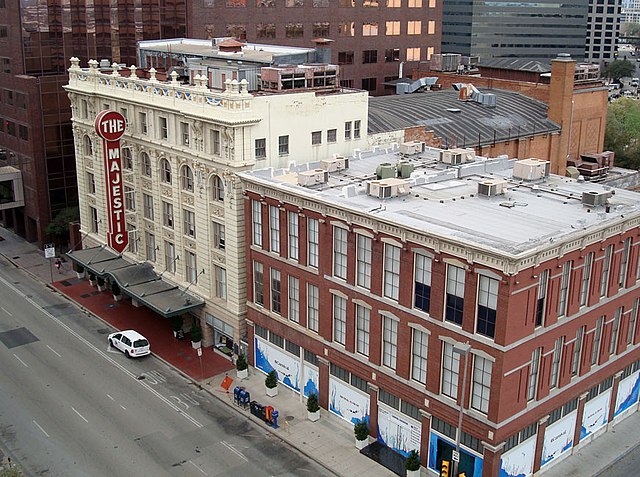
Located in the heart of Downtown Dallas, the Majestic Theatre is a premier venue for the performing arts.
Located in the Harwood Street Historic District, this building is the lone survivor of the city’s former theater district on Elm Street. This building has been designated as a National Historic Landmark and is a Dallas Landmark.
The Hoblitzelle Foundation 1976, donated the Majestic Theater to the City of Dallas, which thereafter renovated it as a performing arts venue.
The original trellises, urns, balustrades, and Corinthian columns of the auditorium were restored together with the building’s facade.
The large interior decorative embellishments were redone with 23 karat gold leaf. Since there needed to be more room for the orchestra, seating was reduced to 1,570 and new ones were built.
The Majestic is now frequently used for concerts, dancing performances, national pageants, and theater.

